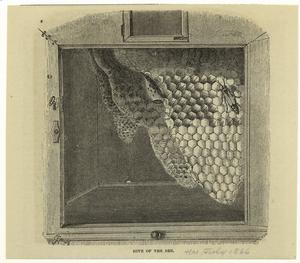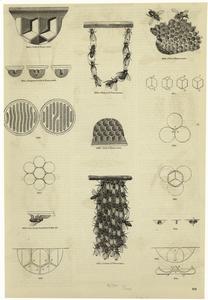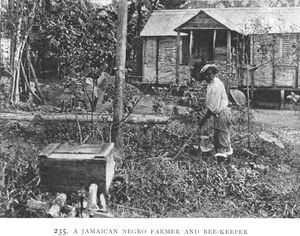3.31.2008
Inspecting Dead Colonies
This weekend, Wren and I had the sad, unpleasant, and yes, fascinating task of trying to ascertain what caused the death of two of our three colonies.
I'll be posting a detailed description, plus many photos, of what we found, but the two key findings were mold (in Green Hive) and mites (in Rebel Rebel hive).
I strongly suspect ventilation problems killed Green Hive. The situation in Rebel Rebel seems a bit more confusing for reasons I'll get into later.
Here's one picture from Rebel Rebel hive. The comb is upside down; I turned the comb over so I could rest the top bar on the hive in order to take the shot. Even in the sad context of "autopsying" a failed colony, it was impossible not to admire the beauty of the bees' cosmopolis.More details on all this coming soon.
3.28.2008
3.27.2008
Urban Bees & How to Help Them
Two worthwhile new articles on the topic of biodiversity among bees in urban settings have caught my wandering eye of late.
The first is the cheerily titled: "Bee Richness and Abundance in New York City Urban Gardens." Incredibly, the authors found 1,145 individual bees representing 54 species while canvassing community gardens in East Harlem and the Bronx. (Props to bee-boy Thew for bringing this one to my attention, and for posting the downloadable PDF on our Brooklyn Beekeeping Meetup, where all can enjoy it. Go here and click the link called "NYC Urban Garden Bees.")The second article appears in the latest issue of Orion, perhaps my all-time favorite magazine. This article, "The Headbonkers Ball," describes the amazing variety of native bees thriving in urban areas of California. Here's a taste:
"As urban and agricultural development in California has obliterated the native bees’ natural habitat, many of the state’s more than fifteen hundred species of natives have adapted and persevered in cities. Urban environments have proved biologically richer than the vast expanses of rural, agricultural land in California. 'It’s like a reservoir of genetic material in these urban environments,' Frankie says. 'All [agricultural areas] have is dirt and the crop that farmers want, and then they bring in bees in a box,' creating what he calls 'a monoculture in bees.'"
(The individual quoted is Gordon Frankie, an entomologist at UC Berkeley who studies native bees, among other interesting things.)
This article's main take-away lesson for those wishing to promote the existence of native bees in their own gardens: lay off the mulch!
Turns out, many native bees (like the humble bumblebee) nest in the ground and the mulch makes it impossible for them to "dig in." So, along with planting native flowers of appeal to native birds, bees, and other pollinating insects, drop the mulch habit and leave some open ground undisturbed for the bees to dig their nests in. I can't think of a more effortless way to create sanctuary.
Want to learn more? Check out this guide to urban bee gardens and bee-friendly gardening.
New Orleans Honeybee Forage
It was great to see so many honeybees during our recent trip to New Orleans. It seemed wherever anything was in bloom—from street meridians on the outskirts of the French Quarter to virtually every square inch of the garden district to the flowering peas in a wreck of a graveyard, the honeybees were there. (We saw some exquisite and unfamiliar butterflies and dragonflies, too. And my first purple martins!)
My macro lens has been failing lately, so instead of bee closeups, I'm providing here a few eh-shots of some of the many flowers on which I saw honeybees forage, plus two bonus shots.
3.25.2008
Bat Crash: The Die-off Continues
More on the frightening threat to that wonderful creature, the bat.
Unwatched Waggle?
My pal Eva was kind enough to bring an interesting New York Times article to my attention today regarding the honeybee waggle dance, distracted bees, and the power of memory.
3.20.2008
3.18.2008
"A Young Deer in a Tiger's Hand": Time, Patience & The Path To Right Action
“Last few days I had a sort of feeling, a tiger, of a young deer in a tiger’s hand. Deer really can fight the tiger? Can express. But actual fight? Our only weapon, only strength is justice, truth. But effect of truth, justice sometimes takes longer time. Weapons power is immediately there.”—Dalai LamaContext, courtesy of the New York Times.
Learn more about the Tibetan culture, the current situation, and the Middle-Way Policy.
(Relevance to beekeeping practice on a scale from 1 to 10: 11.)
3.17.2008
George W. Bush Makes Me Gag
NPR reports on the latest nonsense involving the EPA, the air you breathe, and our sorry excuse for a president:
"The chief of the Environmental Protection Agency has authority to set the air quality standards to protect public health and the environment. But the White House is now interfering with new efforts by EPA Administrator Stephen Johnson."Thank goodness we have only 308 days left—join the countdown.
Chinook Colony Collapse Disorder

In other bad environmental news, there's a disturbing article in today's New York Times about the total disappearance of the Chinook Salmon in the Sacramento River. The article describes the situation as "the almost complete collapse of the richest and most dependable source of Chinook salmon south of Alaska."
Checking on the Hives—Good News and Bad News
This weekend I checked on the hives using the observation windows—still too cold and wet to open them up. Hive Orange appears to be trucking along, but it seems clear that both the Rebel Rebel and Green Hive colonies have died. We had a lot of adventures together, and I'll miss them.
On our next trip up in two weeks, I plan to do a careful assessment/investigation of both of the lost hives and try to figure out what did them in. From what I can see through the observation windows, both colonies have unused, capped honeycomb. Rebel Rebel showed visual evidence of dysentery and some of the combs in the rear of the hive body looked a bit moldy—a sign of ventilation problems, perhaps.
I'll report in a couple of weeks on everything I find in doing the "autopsies" on both hives. If any experienced beekeepers are reading this and wish to comment or share observations, I welcome them.
Here are a couple of shots of what's going on inside Hive Orange. The cluster of bees begins eight bars/combs back from the hive entrance, and extends over a total of 4 combs.The bees were moving around vigorously within the cluster area. There appear to be several capped honeycombs in the middle and rear of the hive.
I want to get in there soon and assess this colony's feeding needs. I can probably transfer some honeycombs from the dead hives to help Hive Orange through until bloom-time. But I don't want to transmit disease from hive to hive, so I need to do a little homework before deciding how best to proceed.
This year, a friend has built larger top bar hive bodies for us to try out; I hope this will allow the bees to save larger stores of honey for wintertime.
In entering Year 2 of my excursion into the manifold wonders of beekeeping, I am awed by how much there is to learn and am eager to "start again" (in the words of Leonard Cohen), letting the bees (and books, and cyber-mentors) teach me what I need to know.
That's what spring is all about, isn't it? Beginning anew and listening closely to Mother Nature's illuminating communiques.
3.15.2008
Beekeeping History @ New York Public Library
The New York Public Library has a fantastic digital collection which includes, among its countless treasures, historical images of beekeeping and natural history.
The first image below, for example, shows a bee hive in Central Park in New York City. I love the rustic features of this hive. Looks a bit like a top bar hive, doesn't it?
Learn more about this historical beekeeping image on the NYPL website.
Learn more about this historical beekeeping image.
Learn more about this historical beekeeping image.
Learn more about this historical beekeeping image.
Learn more about this historical beekeeping image.
Learn more about this historical beekeeping image.
3.14.2008
Evocations of Spring
I gasped with pleasure when I saw this detail of “Wang Xizhi Watching Geese” by Qian Xuan on the New York Times website this morning. Both the image and the title of this painting felt so evocative of spring. The geese suddenly seem to be everywhere and the trees are indicating their intention to bloom and I for one am in a very good mood!
This contemplative image appears in connection with an article about a new show at the Metropolitan Museum of Art entitled “Anatomy of a Masterpiece: How to Read Chinese Paintings.” The new show runs through August 10, 2008. I can't wait to see it.
The Times has another one of its fab slide-shows up, so check out more of Qian Xuan.
You can learn more about this exhibit on the Metropolitan Museum of Art website.
Bee Collage of Bee Collages
At least one of these wonderful bee-collages incorporates beeswax along with imagination—can you tell which one?
1. Beekeeper, 2. bee, 3. Bee Cup, 4. Bee Cup, 5. Bee Tea - 2008, 6. Queen Edith, 7. The Bee tattoo, 8. Sentiment, 9. Queen Of Bees - ATC ACEO
Learn more about beeswax collages.
3.13.2008
New Orleans Beekeepers?
Wren and I are going to New Orleans for a few days and we'd like to connect with any beekeepers in the area. If you're a beekeeper (or know someone who is) in or around New Orleans, we hope you will let us know—leave a comment or see my email in the "Contact" box at right (scroll down a bit).
Bee Transplants & Bees on Trucks
The New York Times has a nice little slide show on a recent honeybee colony removal in North Carolina, though it's not really clear why the bees had to be removed...
In other news—tangentially related to the notion of trucking bees around—check out the cool truck I happened upon today in Brooklyn. I explained to the guy driving it that I'm a beekeeper and asked permission to photograph it. We had a nice conversation about the honeybees; he'd seen the recent 60 Minutes program entitled "What's Wrong with the Bees?" and was concerned.
That's one industrious and patriotic little bee!
Bonus item on the theme of bees and vehicles: some like-minded soul in my neighborhood has this fabulous license plate.
3.12.2008
3.09.2008
Got Pharma-gunk?
 Next time you enjoy a nice glass of drinking water, please be aware that you're likely to be ingesting some of the following "extras" with every sip:
Next time you enjoy a nice glass of drinking water, please be aware that you're likely to be ingesting some of the following "extras" with every sip:
- estrogen and other sex hormones
- sedatives
- pain medications
- psychiatric meds
- anti-convulsants
- antibiotics
- mood stabilizers
--Officials in Philadelphia said testing there discovered 56 pharmaceuticals or byproducts in treated drinking water, including medicines for pain, infection, high cholesterol, asthma, epilepsy, mental illness and heart problems. Sixty-three pharmaceuticals or byproducts were found in the city's watersheds.How could this be happening? Here's the polite way of putting it, from the AP article:--Anti-epileptic and anti-anxiety medications were detected in a portion of the treated drinking water for 18.5 million people in Southern California.
--Researchers at the U.S. Geological Survey analyzed a Passaic Valley Water Commission drinking water treatment plant, which serves 850,000 people in Northern New Jersey, and found a metabolized angina medicine and the mood-stabilizing carbamazepine in drinking water.
--A sex hormone was detected in San Francisco's drinking water.
--The drinking water for Washington, D.C., and surrounding areas tested positive for six pharmaceuticals.
--Three medications, including an antibiotic, were found in drinking water supplied to Tucson, Ariz.
"People take pills. Their bodies absorb some of the medication, but the rest of it passes through and is flushed down the toilet. The wastewater is treated before it is discharged into reservoirs, rivers or lakes. Then, some of the water is cleansed again at drinking water treatment plants and piped to consumers. But most treatments do not remove all drug residue."
Given that, according to the Kaiser Family Foundation, the average American received more than 11 prescriptions in 2006 (that's more than 3 billion prescriptions, total, for one year alone), we're talking massive influx of pharma-gunk into our water supply. Yum!
We've been reading for years about the effects of infusing our water supply with pharmaceuticals, pesticides, and personal care products, but the focus has mostly been on three-headed frogs, intersex frogs, intersex fish, and other harm to wildlife. But who cares about wildlife?
 Now it seems, the intersex chickens are coming home to roost—in our gastrointestinal tracts. Let's call this a case of getting our "just desserts" until we clean up our act.
Now it seems, the intersex chickens are coming home to roost—in our gastrointestinal tracts. Let's call this a case of getting our "just desserts" until we clean up our act.Read the whole sordid, filthy, horrifying and yet unsurprising story here and (for the New York angle, here.)
If you're a bit blue after doing so, calm yourself down with a nice, cool, sedative-laced, mood-stabilizing glass of water.
3.08.2008
Top Bar Hive Spring Management Tips for Beekeepers
 Chomping at the bit for spring? I know I am.
Chomping at the bit for spring? I know I am.
The helpful human named Gary over at Hirschbach Apiary has an interesting and timely article on spring management tips for top bar hives.
The article provides a nice "springboard" for pondering and planning for this exciting time of year.
The Hirschbach Apiary site features lots of good information on top bar hive design, the honeybee life cycle, seasonal management issues, screened bottom boards, ventilation (a highly under-rated challenge in beekeeping), and many other useful details on beekeeping in general and top bar hive beekeeping in particular. The overall approach focuses on sustainable beekeeping methods, with an admirable bias toward elegant simplicity.
The site includes a pithy quote by the wise and wonderful Russell Baker:
"Usually, terrible things that are done with the excuse that progress requires them are not really progress at all, but just terrible things."
Right on, Russell Baker! And right on, Hirschbach Apiaries! Check out the site and start whetting your appetite for beekeeping season '08.
3.07.2008
Virtual Biodiversity: The Encyclopedia of Life
An ambitious new portal called the Encyclopedia of Life (EOL) has just launched. This mega-effort-in-progress aims to document all species of life on Earth (at least the ones humans are aware of—new species continue to be discovered—and no doubt wiped out—all the time).
The site, which is expected to take 10 years to fully realize, includes some nice coverage of various bee species, although—surprisingly—they haven't gotten the honeybee up there yet. I'm sure it's just a matter of time.
Here are some highlights from the EOS website about the project's goals:
* Create a constantly evolving encyclopedia that lives on the Internet, with contributions from scientists and amateurs alike.
* Transform the science of biology, and inspire a new generation of scientists, by aggregating virtually all known data about every living species.
* Engage a wide audience of schoolchildren, educators, citizen scientists, academics and those who are just curious about Earth's species.
* Increase our collective understanding of life on Earth, and safeguard the richest possible spectrum of biodiversity.
The portal is in its nascent phase, so check back over time to enjoy its ever-growing base of information. I certainly plan to explore this resource deeply, all the while remembering that while virtual biodiversity is a wonderful occurrence, the real thing is more glorious by a factor of—oh, I dunno—infinity.
3.05.2008
Swarm This! #4
Intertwingular links of interest.
Today's theme: Critters!
Sex-Changing Chemicals Make Male Starlings Sing Sweet Songs
Scientists Learn Adhesive Lessons from Geckos
Flapping Past Gravity's Pull, Bat Has a Vortex at Its Wings
Expert on Anteaters Wasted Entire Life Studying Anteaters
Hyenas—Sociable, And Smart
2008 Organic Beekeeping Conference, Past & Future
 In February, the Organic Beekeepers group hosted its first conference. Videos, audio recordings, and photos from the gathering are available here.
In February, the Organic Beekeepers group hosted its first conference. Videos, audio recordings, and photos from the gathering are available here.
I haven't had time to explore all this material yet, but it looks like some good info on bee genetics, queen rearing, and "no-treatment" beekeeping can be found here. Join the Organic Beekeepers group to stay apprised of future conferences and events, and to find answers to your burning questions about how to raise "additive-free" bees.
And note the following: "The next two conferences are already in the works. In October, there will be a meeting in Nebraska (organized by Michael Bush), dates, speakers, and details TBD, and again in Oracle, AZ February 27-March 1, 2009 (Friday through Sunday). The cost for the Oracle conference will be the same as for this year ($80 including food and lodging for all 3 days). Updated information on these events will be available on the Organic Beekeeping discussion group, on many of the websites listed below, as well as in Bee Culture and The American Bee Journal."
3.04.2008
Haagen-Dazs, Bee-Dependent Ice Cream, & A Fab Website

Haagen-Dazs—maker of what is, in my opinion, the world's best chocolate ice cream—has launched a stunningly beautiful website to promote its recent efforts to fund honeybee-related research aimed at solving the "mystery" of CCD. Along with a listing of the "bee-dependent" ingredients used in their ice cream (honey being obvious, along with almonds, strawberries, raspberries and other bee-pollinated foods), the site includes a fun "build-your-own-bee" feature. Can you find my drag-queen bee?
Along with a listing of the "bee-dependent" ingredients used in their ice cream (honey being obvious, along with almonds, strawberries, raspberries and other bee-pollinated foods), the site includes a fun "build-your-own-bee" feature. Can you find my drag-queen bee?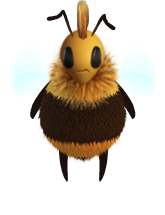 I'm not normally one to tout corporations—my status as an unapologetic MacHead being the sole exception—but credit where it's due: this site design is gorgeous and right now I am drowning out the horrid urban sound-scape of honking car-morons and jackhammers with the site's low-key, chittering bird songs and cricket calls.
I'm not normally one to tout corporations—my status as an unapologetic MacHead being the sole exception—but credit where it's due: this site design is gorgeous and right now I am drowning out the horrid urban sound-scape of honking car-morons and jackhammers with the site's low-key, chittering bird songs and cricket calls.
If Haagen-Dazs puts the same degree of thought and care into its efforts to protect the honeybees as it has in developing this website, we're off to a good start. Let's hope that all companies and individuals whose livelihood depends upon the free labor we extract from honeybees step up to the plate to support not only longterm research, but immediate actions to protect the ecosystem on which we all—human and honeybee alike—depend (a fact that needs no further study). This effort needs to go well beyond PR and funky web design to bring real-world protections to an environment in desperate need of intensive care. Building a virtual bee is cool; building a healthy world and clean environment is—as they say in those Mastercard ads—priceless.
Bee Fun

1. Don't Worry, Bee Happy, 2. BZZZZZZZ!, 3. beeride2, 4. Peace bee with you., 5. Unkl Unipo Series 1- Orange, 6. Bees, 7. Passing By, 8. Untitled, 9. Peace Bee
3.03.2008
The Conspiracy Against Locally Grown Produce
A farmer's perspective on the bureaucratic and economic barriers to delivering fresh, wholesome, locally grown fruits and vegetables to your table.
Greetings from George
Through the wonders of blogger-dom, I've been having a truly delightful correspondence with a beekeeper named George who lives in Romania and runs a nice blog. I was thrilled the other day to receive a kind email from George which included a photo of him in his bee yard saying "howdy," and some "virtual flowers" (primroses?) from his fields in honor of International Women's Day (coming up in a few days). Thanks, George!! I am honored to have this picture from you and may all our bees and flowers flourish.
If you're a beekeeper, send me a photo of you and your hives ("Hi Gerry" sign encouraged, but not required). Just send your photo, your name as you'd like it to appear, and your general location to: globalswarming@gmail.com
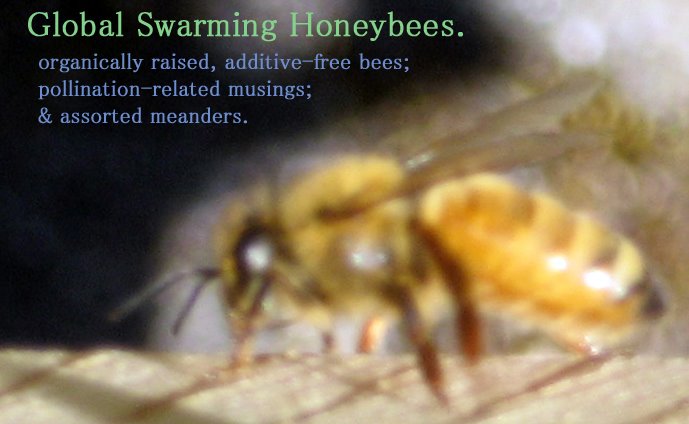


![[Bees and beekeeping.] Digital ID: 806364. New York Public Library [Bees and beekeeping.] Digital ID: 806364. New York Public Library](http://images.nypl.org/?id=806364&t=r)
